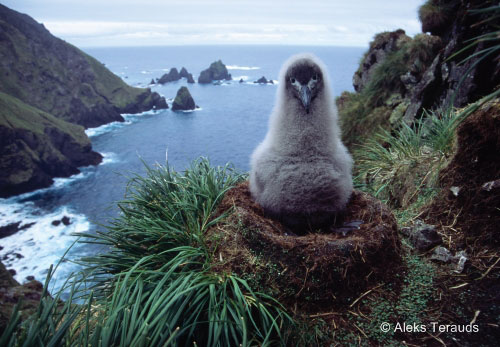Pierre Blévin (Centre d'Etudes Biologiques de Chizé, Centre National de la Recherche Scientifique, Villiers-en-Bois, France) and colleagues, writing in the open-access journal PLoS ONE, have measured mercury levels in seabirds, including ACAP-listed albatrosses and petrels, at the French Kerguelen Islands in the southern Indian Ocean.
The paper's abstract follows:
"Using top predators as sentinels of the marine environment, Hg contamination was investigated within the large subantarctic seabird community of Kerguelen Islands, a remote area from the poorly known Southern Indian Ocean. Chicks of 21 sympatric seabirds presented a wide range of Hg concentrations, with the highest contaminated species containing ~102 times more feather Hg than the less contaminated species. Hence, Kerguelen seabirds encompass the whole range of chick feather Hg values that were previously collected worldwide in poorly industrialized localities. Using stable isotopes, the effects of foraging habitats (reflected by δ13C) and trophic positions (reflected by δ15N) on Hg concentrations were investigated. Species-related Hg variations were highly and positively linked to feather δ15N values, thus highlighting the occurrence of efficient Hg biomagnification processes within subantarctic marine trophic webs. By contrast, Hg contamination overall correlated poorly with feeding habitats, because of the pooling of species foraging within different isotopic gradients corresponding to distinct seabird habitats (benthic, pelagic, neritic and oceanic). However, when focusing on oceanic seabirds, Hg concentration was related to feather δ13C values, with species feeding in colder waters (lower δ13C values) south of Kerguelen Islands being less prone to be contaminated than species feeding in northern warmer waters (higher δ13C values). Within the context of continuous increase in global Hg emissions, Kerguelen Islands that are located far away from anthropogenic sources can be considered as an ideal study site to monitor the temporal trend of global Hg contamination. The present work helps selecting some seabird species as sentinels of environmental pollution according to their high Hg concentrations and their contrasted foraging ecology."

How much mercury? A Light-mantled Sooty Albatross chick
Photograph by Aleks Terauds
Reference:
Blévin, P., Carravieri, A., Jaeger, A., Chastel, O., Bustamante, P. & Cherel, Y. 2013. Wide range of mercury contamination in chicks of Southern Ocean seabirds. PLoS ONE 8(1): e54508. doi:10.1371/journal.pone.0054508.
John Cooper, ACAP Information Officer, 30 January 2012

 English
English  Français
Français  Español
Español